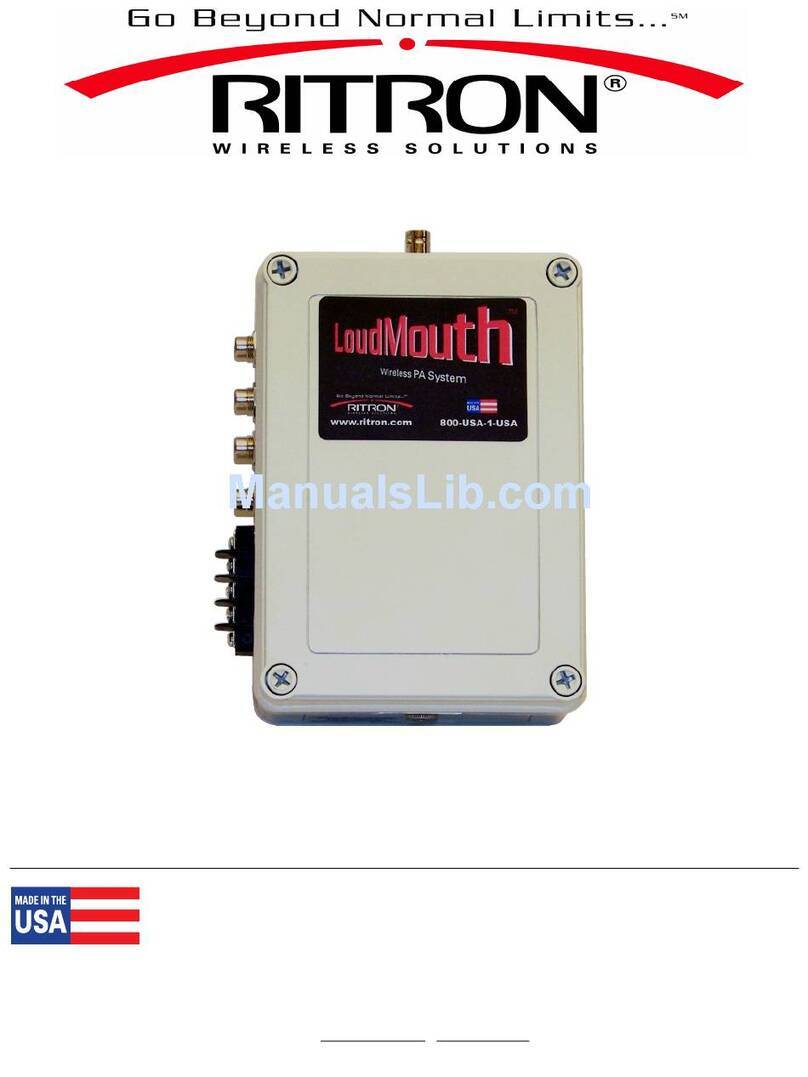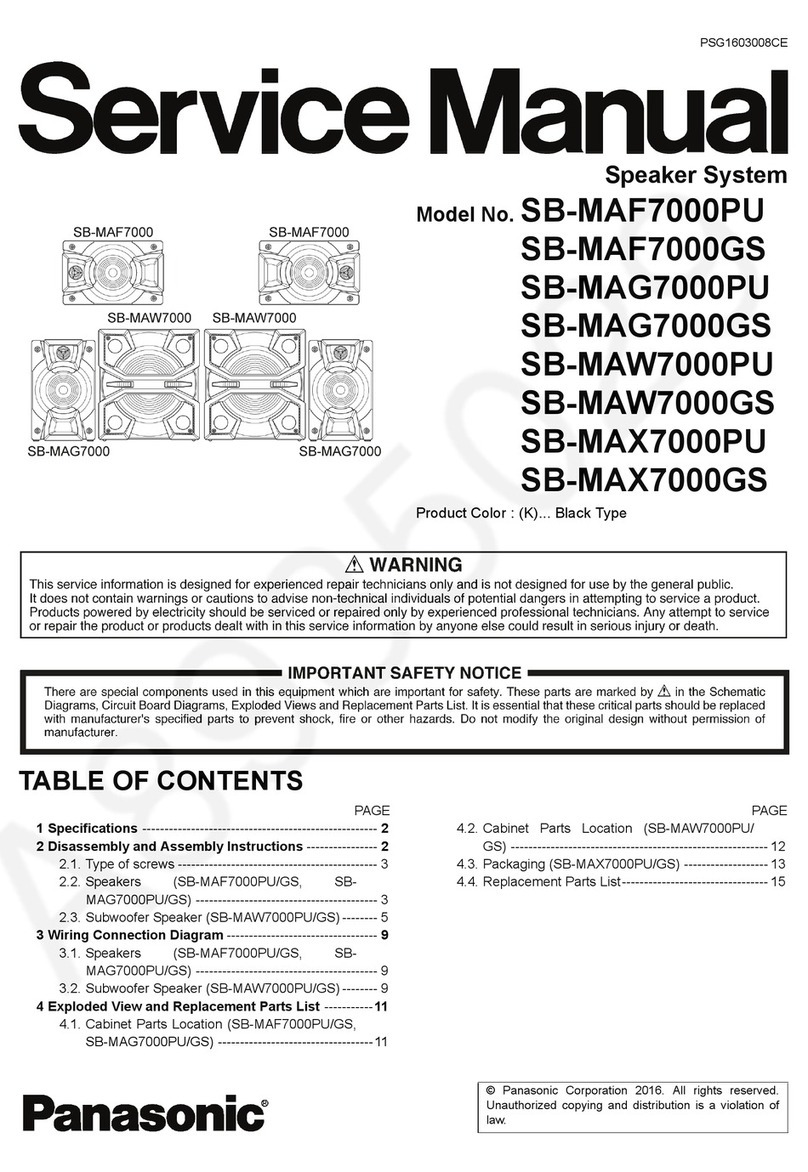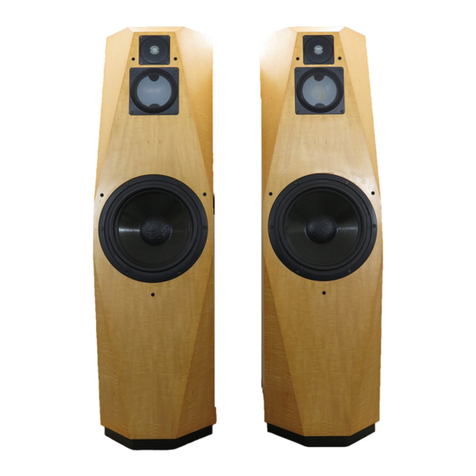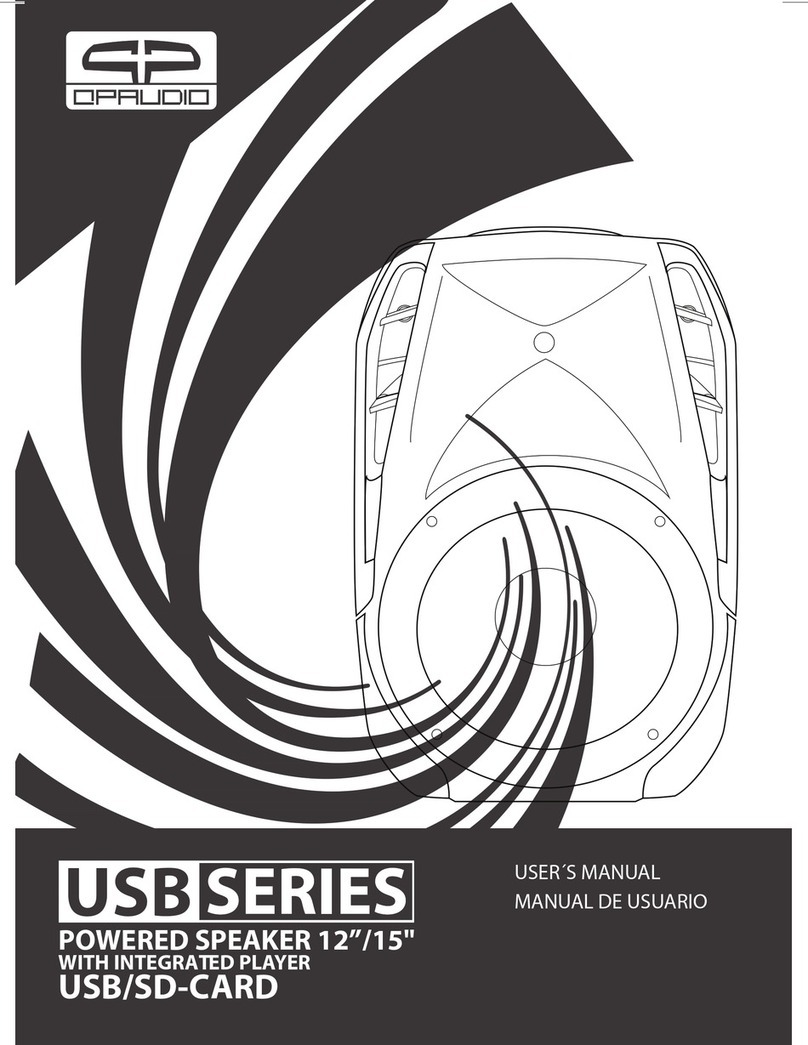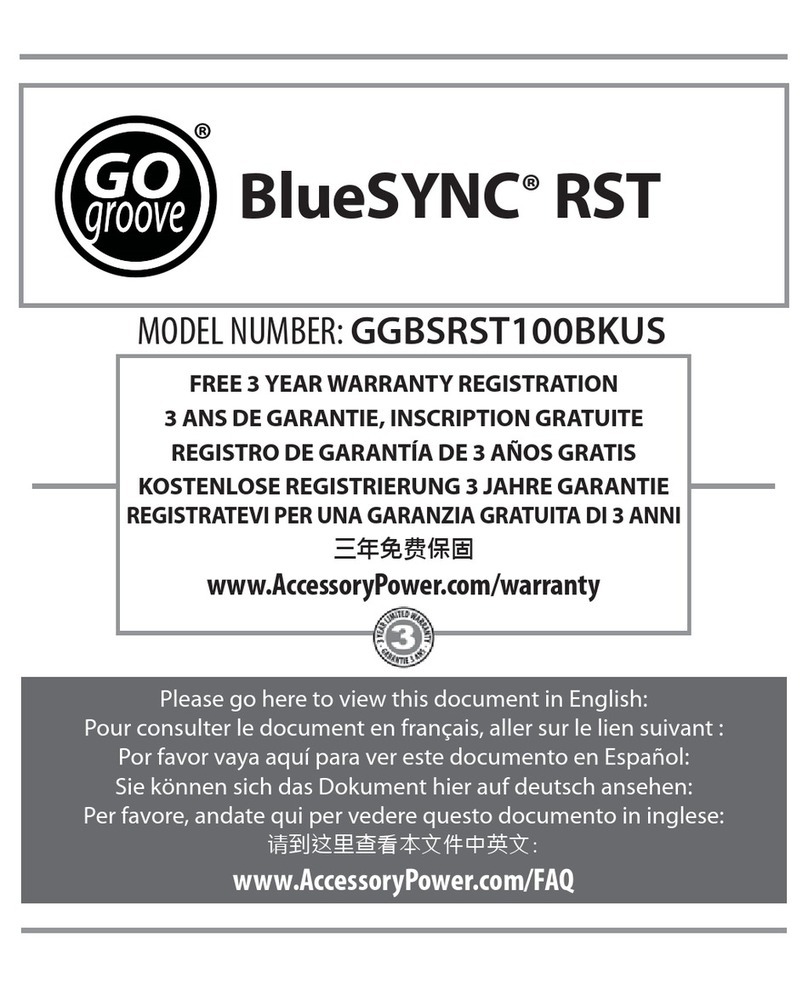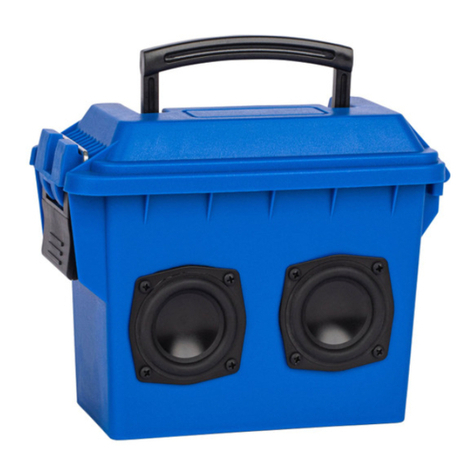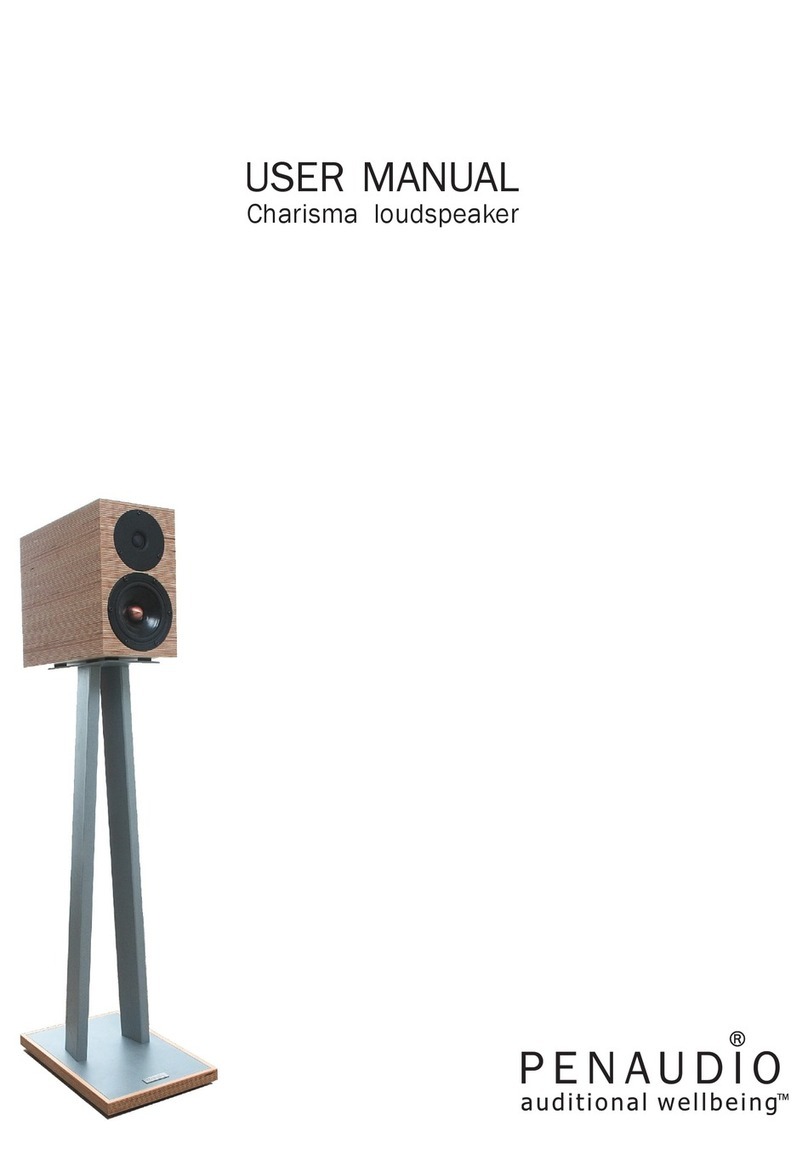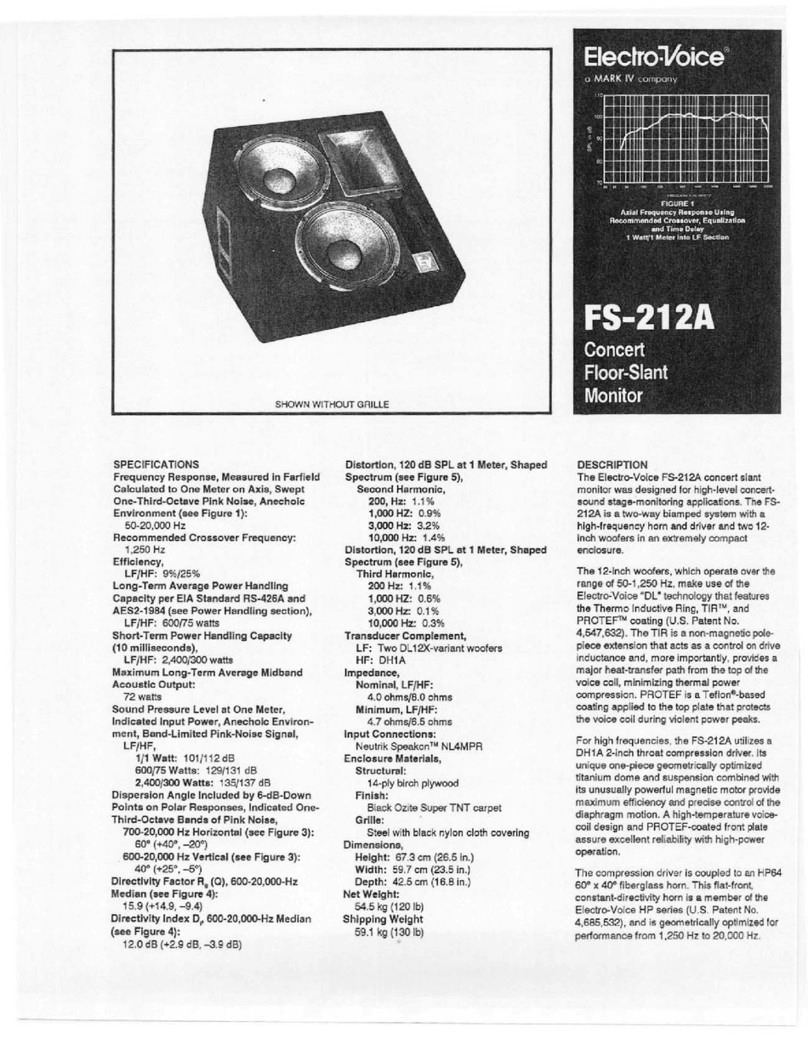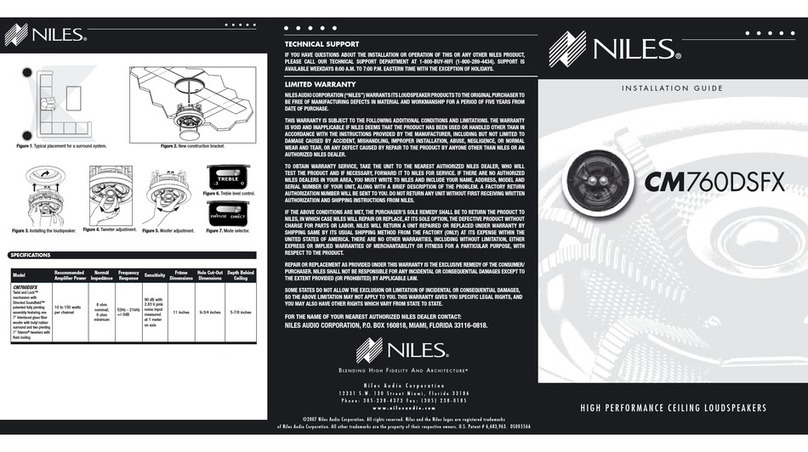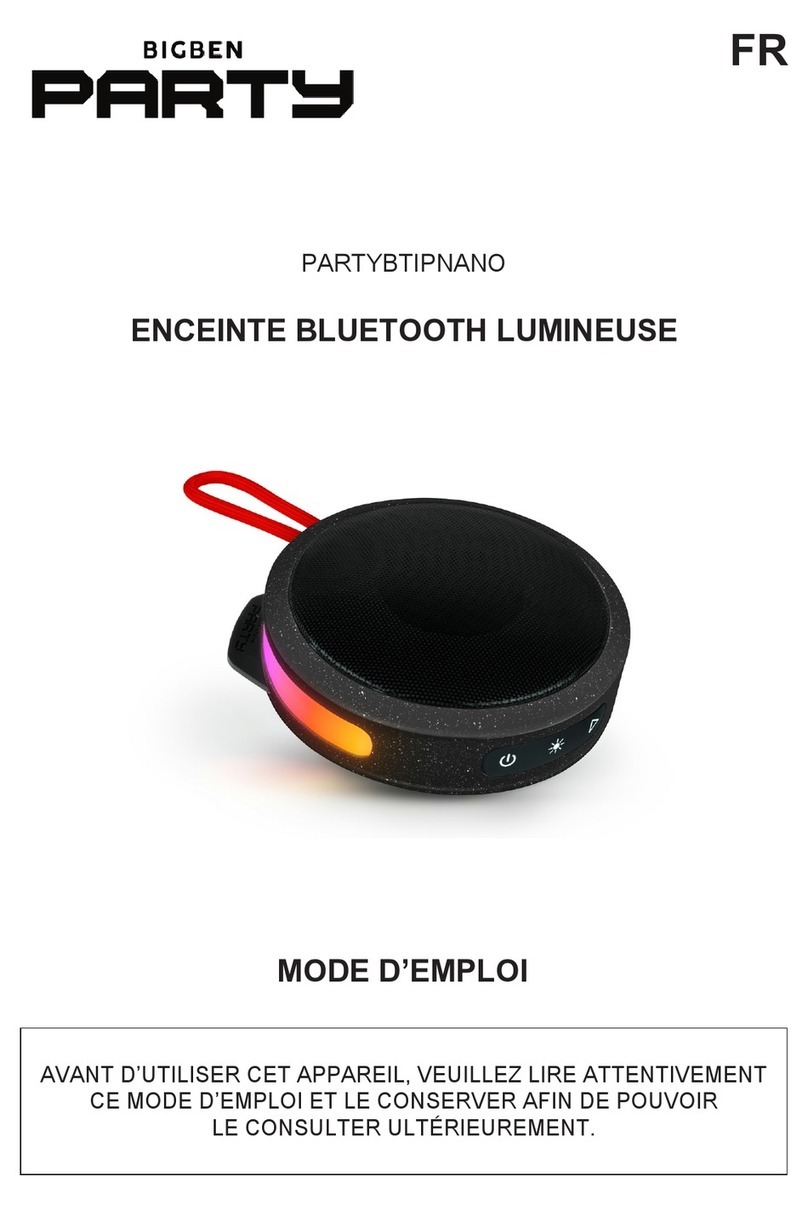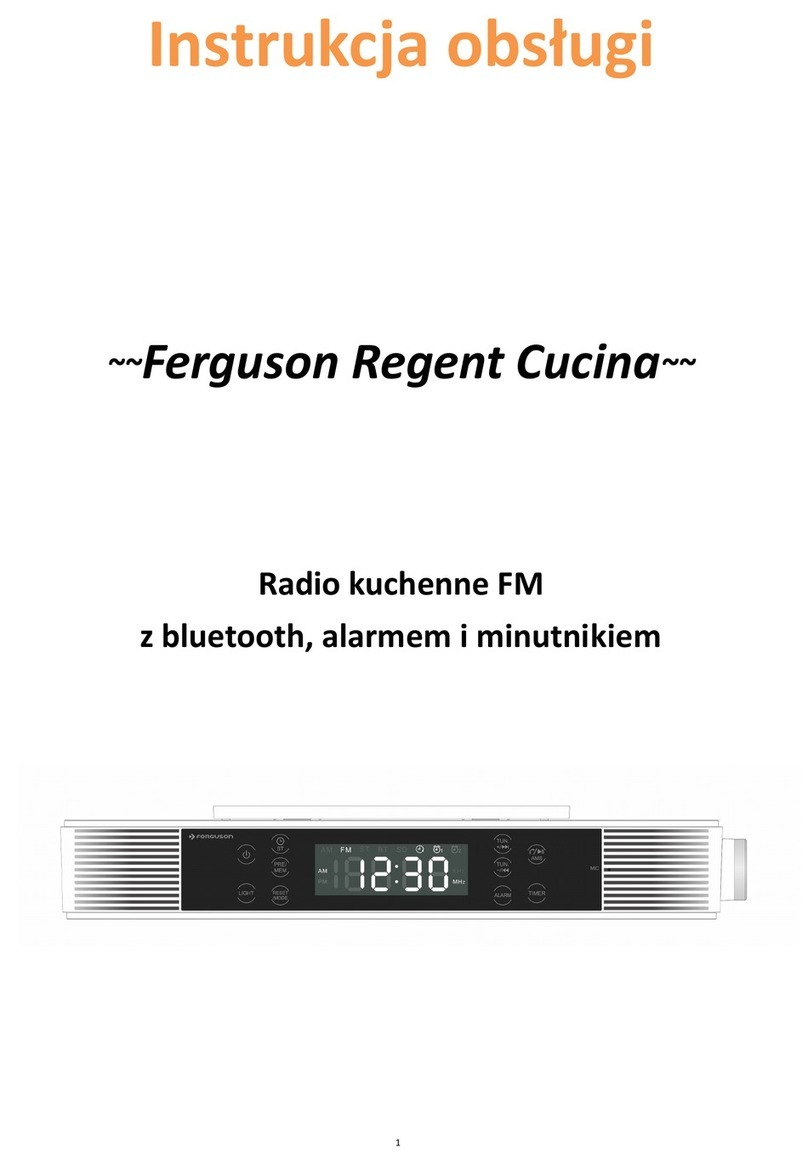Ritron Jobcom J Series J-U410 User manual

Ritron Pub. 14500060 Rev. B 03/08
© 2008 Ritron, Inc. All rights reserved. Ritron, Patriot, Jobcom, OutPost, GateGuard, Quiet Call and
Quick Assist are registered trademarks of Ritron, Inc. Loudmouth, Quick Talk, Liberty and RadioNexus
are trademarks of Ritron, Inc.
Call 800-USA-1-USA
For the right Wireless Solutions for your communication needs.
P.O. Box 1998 ·Carmel, Indiana 46082-1998 · 317-846-1201 · Fax: 317-846-4978
Owner’s Manua
l


Table of Contents
1Getting Started
1.1 Loudmouth™receiver and PA speaker equipment ............................................................................... 1
1.2 Loudmouth™receiver assembly ........................................................................................................... 2
1.3 Paging the Loudmouth™receiver and PA speaker............................................................................... 3
1.4 Compatibility with other RITRON model radios .................................................................................... 4
1.5 Determine the volume setting............................................................................................................... 5
2Installation
2.1 Selecting the PA speaker location........................................................................................................ 6
2.2 PA speaker installation......................................................................................................................... 8
2.3 Loudmouth™radio receiver installation................................................................................................. 9
2.4 Installing two PA speakers with a single Loudmouth™receiver.......................................................... 10
2.5 Installing multiple Loudmouth™receivers and PA speakers............................................................... 11
2.6 Vehicular installation........................................................................................................................... 12
2.7 Temporary outdoor installation........................................................................................................... 12
3Programming
3.1 Loudmouth™Field Programming Overview........................................................................................ 13
3.2 Readout Current Frequency, Tone and Selective Signaling Codes.................................................... 14
3.3 Program Frequency & Tone Codes.................................................................................................... 15
Table 1: Programmable Frequency Codes ................................................................................. 16
Table 2: Interference Eliminator Programmable QC Tone Codes............................................... 16
Table 3: Digital Interference Eliminator Programmable DQC Tone Codes ................................. 16
3.4 Program Paging Codes...................................................................................................................... 17
Table 4: 2-Tone Paging Codes ................................................................................................... 17
3.5 Program Loudmouth™Features ......................................................................................................... 18
Table 5: Loudmouth™Feature Codes......................................................................................... 18
3.6 Program Loudmouth™Volume ........................................................................................................... 19
Checking the current volume setting............................................................................................... 19
3.7 Program the NOAA Weather Frequency............................................................................................ 20
Table 6: NOAA Weather Frequency Codes................................................................................ 20
4Operation
4.1 Basic Operation.................................................................................................................................. 21
4.2 Selcall Paging..................................................................................................................................... 21
4.3 2-Tone Paging.................................................................................................................................... 22
4.4 Record and Play................................................................................................................................. 22
4.5 Weather Alert...................................................................................................................................... 23
4.6 Battery Powered Operation ................................................................................................................ 23
4.7 Loudmouth™Options.......................................................................................................................... 24
4.8 How to Minimize Feedback ................................................................................................................ 24
5Specifications
5.1 Audio Output....................................................................................................................................... 25
5.2 Power Requirements.......................................................................................................................... 26
5.3 Loudmouth™Speaker......................................................................................................................... 26
5.4 RPS-1A Power Cube.......................................................................................................................... 26
5.5 Loudmouth™Receiver........................................................................................................................ 27
Field Programming Map..................................................................................................................... 28
6Warranty................................................................................................................................................. 29

1 Section 1 Getting Started
1 Getting Started
The Loudmouth™is a radio receiver that allows you to use your portable, base
station or mobile 2-way radio to deliver voice messages directly to a PA speaker
up to 2 miles away. The receiver and PA speaker is the ideal solution where hard-
wired PA installation is simply impossible, too expensive, or temporary.
Your Loudmouth™receiver and PA speaker has been designed so that you can set
it up quickly and start using it right away.
1.1 Loudmouth™receiver and PA speaker equipment
Check your package to be sure you received all the equipment necessary to install the Loudmouth™receiver and
PA horn speaker.
List of items included with your Loudmouth™receiver and PA speaker:
LM-U450 or LM-V150........Loudmouth™Radio Receiver 5W audio amplifier
05500040 ..........................Horn Speaker with RCA phono plug and 25 ft. cable
RPS-1A.............................Power Cube, 1A with 2.1mm coaxial DC connector
BP-LM9.............................Emergency Backup battery pack, 10.8VDC, 800mAH
AFB-1545..........................Wideband Antenna with BNC connector
RK-RQX-MB .....................Mounting Brackets
14500060 ..........................Loudmouth™User Manual
* Ritron portable JMX-446D is also included when ordering the LM-U450SYSTEM, and the JMX-144D
portable is included when ordering the LM-V150SYSTEM.
Antenna
* Portable Radio
(optional)
Power Cube
Horn Speaker
Backup Battery
Loudmouth™ Receiver
Mounting Brackets
Need
replacement
items?
Contact your Ritron
dealer, or Ritron
directly at
800-USA-1-USA

Section 1 Getting Started 2
1.2 Loudmouth™receiver assembly
The Loudmouth™receiver and PA speaker is on any time power is applied to the receiver. For this reason the BP-
LM9 backup battery included with the Loudmouth™is not connected when you receive it from the factory.
The Loudmouth™ receiver must be opened to connect the BP-LM9 battery, install the Mounting Bracket, or to
program the Loudmouth™.
1. Loosen the (4) captive screws in the front corners of the case. These screws are captive to the housing; to
prevent damaging them, DO NOT remove the screws from the housing.
2. Separate the case front from the case back.
3. Install the Mounting Brackets by inserting the 4 sealed screws included in the Mounting Bracket kit into the
4 pre-drilled holes shown above. Secure the Mounting Brackets to the case using the lockwashers and nuts
included in the Mounting Bracket kit.
4. Connect the BP-LM9 backup battery to the Loudmouth™receiver using the red mating connectors shown
above. The BP-LM9 is secured to the case front with interlocking mushroom-head fastener strips. Press firmly
on the battery to interlock the strips, snapping it into position.
5. Program the Loudmouth™ receiver per the instructions in the Programming section of this manual, leaving
the RPS-1A power supply or BP-LM9 backup battery connected to the radio. Press the Enter button twice
before re-assembling the case to be sure the Loudmouth™is reset and ready for operation.
6. Carefully position the case front onto the case back. Secure the case halves by tightening the 4 captive
screws in the front corners of the case.
PROGRAMMING
Enter Button
Program Display
Program Button
RJ-11 Program
Cable Connector
DC Power Connecto
r
for RPS
-
1A
RCA Phono Jack for
S
p
eaker Connection
BP-LM9
Battery
BNC Antenna Connector
for AFB
-
1545
Pre-drilled holes for Mounting
Bracket (4 corners)
Captive Plastic Case
Screws
(
4 corners
)

3 Section 1 Getting Started
1.3 Paging the Loudmouth™receiver and PA speaker
The Loudmouth™receiver and PA speaker can be paged with 2-way radios programmed for Quiet Call (CTCSS),
Digital Quiet Call (DCS), 2-Tone Paging, or Selcall paging formats. Each format offers a unique method of paging
the Loudmouth™receiver and PA speaker.
Refer to the Programming section of this manual for specific instructions on programming your Loudmouth™
receiver and PA speaker to one of these selective signaling formats.
Ritron strongly recommends operation of the Loudmouth™receiver and PA
speaker with one of the following selective signaling formats enabled.
Paging the Loudmouth™with Quiet Call (CTCSS) only:
•To page the loudspeaker a user simply presses the 2-way radio’s PTT and speaks while on the
Loudmouth™ channel.
•Your 2-way radio must be programmed for a channel dedicated to Loudmouth™ operation. Only those
radios programmed with the Loudmouth™ channel will be able to access the loudspeaker.
•The 2-way radio’s Loudmouth™ channel and the Loudmouth™ receiver must be programmed for the
same QC code. All Ritron radios offer 50 different field-programmable QC codes from which to choose.
Paging the Loudmouth™with Digital Quiet Call (DCS) only:
•To page the loudspeaker a user simply presses the 2-way radio’s PTT and speaks while on the
Loudmouth™ channel.
•Your 2-way radio must be programmed for a channel dedicated to Loudmouth™ operation. Only those
radios programmed with the Loudmouth™ channel will be able to access the loudspeaker.
•The 2-way radio’s Loudmouth™ channel and the Loudmouth™ receiver must be programmed for the
same DQC code. All Ritron radios offer 104 different field-programmable DQC codes from which to
choose.
Paging the Loudmouth™with 2-Tone Paging:
•To page the Loudmouth™ the 2-way radio must first send the correct 2-Tone Paging code. Once
access to the loudspeaker is accomplished, the user simply presses the 2-way radio’s PTT and speaks
while on the Loudmouth™ channel. After a period of inactivity the Loudmouth™ is automatically reset,
and will then require the correct 2-Tone Paging code to re-gain access.
•Only 2-way radios programmed to send the correct 2-Tone code on the Loudmouth™channel can
access the Loudmouth™wireless PA speaker. However, once access is gained, any 2-way radio that
operates on the Loudmouth™channel can access the loudspeaker up until the time that the
Loudmouth™has automatically reset.
•Can be used in conjunction with QC or DQC for added security. The 2-way radio and the Loudmouth™
receiver must be programmed for the same QC or DQC code.
Paging the Loudmouth™with Selcall:
•To page the Loudmouth™ the 2-way radio must be programmed to send the correct Selcall code every
time the PTT is pressed. The user simply presses the 2-way radio’s PTT and speaks while on the
Loudmouth™ channel.
•Only 2-way radios programmed to send the correct Selcall code on the Loudmouth™channel can
access the Loudmouth™wireless PA speaker.
•Can be used in conjunction with QC or DQC for added security. The 2-way radio and the Loudmouth™
receiver must be programmed for the same QC or DQC code.

Section 1 Getting Started 4
Ritron recommends the use of a dedicated channel frequency for
Loudmouth™operation.
When operating on unique frequencies dedicated to loudspeaker operation:
•Your 2-way radios must be programmed for a channel dedicated to loudspeaker operation.
•Loudspeaker operation is limited to radios programmed with the dedicated Loudmouth™channel.
•The use of 2-tone or Selcall paging to address the Loudmouth™is not required, but can still be used if
additional access security is desired.
•Without 2-tone or Selcall paging the loudspeaker can be addressed by simply selecting the
Loudmouth™channel on your 2-way radio and pressing the PTT button to talk.
•You may need to license additional frequencies (not necessary with LM-V150 programmed for MURS
frequencies, see Table 1 in the Programming section).
When operating on your normal 2-way communication frequencies:
•Messages broadcast on the Loudmouth™are also heard on your 2-way radios.
•Loudspeaker messages are not possible when the channel is being used for 2-way communications.
•The use of 2-tone or Selcall paging is required to address the Loudmouth™, otherwise all 2-way
communication is heard on the loud speaker.
•Any user on your 2-way channel can broadcast over the loudspeaker once it is activated, even if their
2-way radio is not programmed with the correct 2-tone paging code.
•There is no need to license additional frequencies.
1.4 Compatibility with other RITRON model radios
The Loudmouth™receiver and PA speaker is available in both VHF (LM-V150, 150-165 MHz) and UHF (LM-U450,
450-470 MHz) business band frequencies. Loudmouth™can be accessed with radios programmed for Quiet Call
(CTCSS), Digital Quiet Call (DCS), 2-Tone Paging, or Selcall paging formats. The following chart can be used to
determine compatibility with existing Ritron radios.
VHF models compatible with LM-V150 UHF models compatible with LM-U450
2- 2-
Model Type QC DQC Tone Selcall Model Type QC DQC Tone Selcall
JMX-141D Portable √JMX-441D Portable
√
JMX-144D Portable √√√JMX-444D Portable
√√√
JMX-146D Portable √JMX-446D Portable
√√√
JBS-146D Base √√√JBS-446D Base √√√
* J-V110 Portable √√√* J-U410 Portable
√√√
RPM-160 Mobile √√√√RPM-460 Mobile √√√√
RQX-151 Callbox √√RQX-451 Callbox
√√
RQX-156 Callbox √√√RQX-456 Callbox √√√
RQX-157 Callbox √√√RQX-457 Callbox √√√
SLX-100 Portable √√√√SLX-400 Portable √√√√
*2-Tone paging available with Rev 6 Firmware Only. See label inside radio battery compartment for
firmware revision.

5 Section 1 Getting Started
1.5 Determine the volume setting
Selecting the correct volume level is critical to the performance of the Loudmouth™receiver and PA speaker.
Carefully consider the following before deciding on the appropriate volume setting. Refer to the Programming
section of this manual for specific instructions on programming the Volume Level.
Ambient (average) noise level should be considered first when selecting the
volume level.
Increasing the volume level in an effort to cover a wider area will result in:
•Undesirably high volume when near the speaker.
•Low volume at the outer edges of the coverage area.
•A calling radio must be a greater distance from the Loudmouth™speaker to prevent feedback.
(Feedback is the result of Loudmouth™speaker audio getting into the calling radio’s microphone.)
When coverage of a large area is required, additional Loudmouth™speakers may be necessary for
satisfactory performance. See the Installation section of this manual for details on how to install 2 speakers
using a single Loudmouth™receiver, or multiple receivers and speakers.
1. Refer to the horizontal shaded bars on the chart below to
determine the sound level that best represents your
location. This should be the ambient, or average sound
level. We will consider the maximum sound level when
we locate the speaker.
2. Estimate the maximum distance (in feet) that the
loudspeaker must be heard. Locate that distance on the
chart below and follow it up to find the line that is in the
middle of your shaded bar. This line indicates the
optimum Loudmouth™volume level setting.
Loudmouth Volume
Rock Music
Subway Train
Industrial Factory
Warehouse
Bus
y
Restaurant
Lar
g
e Office
Hos
p
ital
Doctors Office
0 10 20 30 40 50 60 70 80 90 100
Distance (Feet)
120
110
100
90
80
70
60
50
40
SPL
(dB) 10%
25% 50% 75%
100%
EXAMPLE: In the Ritron factory we
need to cover a maximum distance of 50
feet on the factory floor with an ambient
sound level similar to a warehouse. I
find the vertical line at the bottom of the
chart indicating 50 feet, and follow it up
to the shaded bar indicating Warehouse.
The 50% and 75% lines are in the middle
of the Warehouse bar, indicating a
required Loudmouth™volume setting
between 50 - 75%.

Section 2 Installation 6
2 Installation
Proper installation of the Loudmouth™wireless PA speaker is critical to the
performance and overall satisfaction with your system. With careful consideration
and planning Loudmouth™ will cover up to 100 feet with a single speaker, and can
cover an even wider range with multiple speakers and receivers. This section will
help you plan an installation that is best suited for your environment.
2.1 Selecting the PA speaker location
Speaker location is critical to the performance of the Loudmouth™ receiver and PA speaker. Consider the
following factors before selecting a speaker location.
•The speaker can be installed either indoors or outdoors.
•Be sure there is a convenient source of 110VAC power for the RPS-1A power cube and that the radio receiver
box can be located inside, out of the elements. The speaker has a 25 ft. cable, if you need more a standard
RCA phono cable and coupler can be used (ie. Radio Shack Catalog #: 42-2363 and Catalog #: 274-1553).
•The speaker should not be in an area where the 2-way radio user addressing the speaker will typically be
located. If the radio user is too close to the Loudmouth™speaker, feedback can occur due to loudspeaker
audio getting into the radio microphone. This is a problem related to the 2-way radio, not the Loudmouth™
speaker. The use of the Record & Play feature will eliminate this problem.
The speaker must be located at least 10 feet above head level.
At near range the Loudmouth™speaker is capable of sound levels that can cause
permanent hearing loss and should never be installed in a location where a person
could be directly in front of the speaker.
Install the Loudmouth
™
speaker close to the noisiest area you plan to cover.
If there is an area with a significantly higher ambient noise level, the Loudmouth™
speaker should be located as close as possible to this area. The speaker volume
must be 6 db higher than the ambient noise level in order to be heard.
If the speaker is not close to the highest source of noise, the
volume level will be too loud for the quieter areas.

7Section 2 Installation
Large obstructions will significantly reduce the coverage area.
Do not place the speaker behind large, tall objects.
The Loudmouth
™
speaker should be mounted as high as practical and
pointed toward the farthest location you need to cover.

Section 2 Installation 8
2.2 PA Speaker installation
The speaker mount can be installed vertically on a wall,
flat post or support column; or can be mounted
horizontally from a ceiling or rafter beam.
Once the speaker location has been determined the
Speaker Mounting Template may be used to mark the
mounting surface. When using the Speaker Mounting
Template keep in mind that the speaker wire exit is toward
the floor on a wall mounted installation, and toward the
front of the speaker in a ceiling mounted installation.
The Loudmouth™speaker may be secured to a variety of
surfaces, with each installation presenting unique
requirements for mounting hardware. With this in mind,
mounting screws or hardware are not included with the
Loudmouth™.
Guidelines for mounting the Loudmouth™speaker:
•The Loudmouth™speaker can be safely mounted to concrete, metal or wood surfaces. Other surfaces are
possible provided they can support the weight of the speaker. If mounting to a drywall or concrete surface
the use of expansion anchors is recommended.
•Secure the speaker tightly to the mounting surface, using all 6 mounting holes if possible. At high audio
output levels the speaker can generate significant vibration and must be rigidly secured. This is particularly
critical with drywall surfaces, which are highly susceptible to vibration damage.
•Be sure the speaker wire exits cleanly from under the speaker mounting bracket through the wire exit
tunnel provided. Pinching the speaker wires could cause a short that will destroy the Loudmouth™receiver
audio amplifier.
•Route the speaker wire closely against a wall or support
beam. Speaker wire hanging in free space is easily
snagged and could be pulled from the Loudmouth™
receiver or worse yet, pulled from the speaker itself
causing permanent damage.
•1 inch long, #8 or #10 round-head screws should be
used to mount the speaker. Wood screws, sheet metal
screws, machine screws with nuts, or drywall anchors
and screws will all work well depending on your specific
requirements. Pan-head screws should not be used to
prevent damage to the mounting bracket due to over-
tightening.
REAR
Ceiling mounted
TOP
Wall mounted
TOP / REAR
Speaker
Mounting
Template
Speaker
wire exit
Wood Screw
Sheet Metal Screw
Machine Screw with Nut
Drywall Anchor and Screw

9Section 2 Installation
The Loudmouth™speaker should be mounted
horizontally for the widest coverage
When mounted horizontally the Loudmouth™
speaker will provide 90° horizontal and 60°
vertical coverage without significant loss of sound
level. Refer to the SPL chart on page 25 for
typical sound levels at full volume.
2.3 Loudmouth™radio receiver installation
Installation of the Loudmouth™receiver is critical to the effective radio coverage of the radio loudspeaker system.
Without proper installation the maximum possible distance between the calling radio and the Loudmouth™
receiver will be significantly reduced.
Guidelines for installing the Loudmouth™receiver:
•The radio receiver box must be located inside, out of the elements.
•Be sure there is a convenient source of 110VAC power for the RPS-1A power cube.
•The Loudmouth™receiver should be installed in a central location and as high up as possible for best radio
coverage.
•For maximum radio coverage the antenna should be in a vertical orientation and should not be touching or
surrounded by large metal objects. The receiver box can be mounted horizontally as long as the antenna is
in a vertical position.
•Do not install the Loudmouth™receiver in a high traffic location with the possibility that the receiver box
would be struck, become unplugged, or the speaker be disconnected.
•Do not wind, loop or otherwise allow the power cord from the RPS-1A power cube to contact the antenna.
The power cord should be routed away from the antenna.
Radio range can be extended with the use of an external
antenna.
The antenna can be installed at a higher elevation than is possible with the
attached antenna.
The Ritron RAM-1545 VHF/UHF magnet-mount antenna has a 25 ft.
cable to allow optimum antenna location.
Installing Concrete Expansion Anchors
1. Drill hole of recommended
diameter, see chart below, into the
base material to a depth equal to,
or slightly deeper than the length
of the expansion shield. Clean out
the hole of all dust and cuttings.
2. Place the Single Expansion
anchor, nut end first, into the hole.
The top end of the anchor should
be flush or slightly below the base
material surface.
3. Place the object to be fastened
over the anchor in the base
material and bolt into place. The
bolt should engage 2/3 of the
threads of the anchor.

Section 2 Installation 10
2.4 Installing two PA speakers with a single Loudmouth™receiver
Many locations may require the installation of two speakers with a single Loudmouth™
receiver. Two speakers are used when:
•Coverage is required over a large area.
•Large obstructions limit the effective range of a single speaker.
•A wall separates two coverage areas.
•The ambient noise level is low and individual speaker volume must be reduced
(i.e. Hospital).
•The calling radio is in the area where the speakers are located and speaker
volume must be reduced to prevent feedback.
In some installations a single Loudmouth™receiver can be used to drive two
speakers, while others will require a separate receiver for each speaker.
To cover a large area, or an area with large obstructions, place 2 speakers
back-to-back in a central location.
•The speakers should be mounted as high as possible and pointing away from each other.
•The 2 speakers can be driven by a single Loudmouth™receiver.
•Volume level may be reduced compared to a single speaker, making the system less susceptible to
feedback.
Use 2 Speakers to reduce volume level
Surprisingly, the use of 2 speakers powered by a single
Loudmouth™receiver can allow you to reduce the volume
level in a quiet environment.
By covering an area with 2 centrally located speakers,
installed back-to-back, the volume level can be cut in half.
You can connect 2
speakers to a single
Loudmouth™receiver
using an RCA phono
type Y-connector.
(i.e.Radio Shack
Catalog # 274-881)

11 Section 2 Installation
2.5 Installing multiple Loudmouth™receivers and PA speakers
Many locations may require the installation of multiple Loudmouth™receivers and PA speakers. Multiple receivers
and PA speakers are used when:
•Paging separate buildings is required.
•The coverage area is too large for a single receiver and PA speaker.
•Zone paging is required.
•Paging is required in more than one location.
Zone paging, or paging in more than one location requires a separate
Loudmouth™receiver for each area.
•With zone paging all radios can operate on the same Loudmouth™radio frequency.
•Each Loudmouth™receiver can be programmed for a unique paging code, allowing selective paging to
each zone.
•The Loudmouth™receivers can be programmed for an All Call* code that allows paging of all zones at
once, or Group Call* to page more than one zone.
•Zone paging allows for volume levels that are programmed to the specific needs of that area.
•If zone paging is not necessary, all Loudmouth™receivers can be programmed for the same paging
code.
* All Call and Group Call code programming requires the Ritron Loudmouth™PC Programmer.
Example of Zone paging
Zone 1 – Warehouse and loading dock
•Single Loudmouth receiver with 2 speakers.
•One speaker is located inside the warehouse and the
other is located outside for the loading dock.
•Speaker volume is set to 50% for the warehouse
environment.
Zone 2 – Cafeteria
•Single Loudmouth receiver with 1 speaker.
•The speaker is located inside the cafeteria area.
•Speaker volume is set to 25% for the restaurant
environment.
Zone 3 – Sales office
•Single Loudmouth receiver with 1 speaker.
•The speaker is located inside the Sales office.
•Speaker volume is set to 10% for the office environment.

Section 2 Installation 12
2.6 Vehicular installation
The Loudmouth™receiver can be powered with an optional Ritron model CCL-M cigarette lighter adapter for use in
mobile applications.
•Route the CCL-M power cord away from the antenna and speaker wires.
2.7 Temporary outdoor installation
The Loudmouth™receiver can be temporarily installed outdoor with the use of weatherproof enclosures.
The Ritron model LMH-100 is a weatherproof, fiberglass reinforced polyester enclosure
designed to house the Loudmouth™receiver and antenna. Speaker and power
connections are routed from the bottom of the enclosure through electrical conduit.
The LMH-100 includes:
•Dual stainless steel, padlockable latches
•Nema 3 weatherproof, fiberglass reinforced polyester enclosure
•Mounting flanges for flat surface
•Dimensions: 13”H x 10.5”W x 5.5”D Weight: 8 lbs.
Ritron model RSS-100 10W solar panel kit can be used to power the Loudmouth™
receiver without the need for the RPS-1A power supply in locations where AC power is
not available.
The RSS-100 includes:
•10-Watt solar panel with mounting bracket
•7AH sealed rechargeable battery
•Solar charge controller
•Nema 3 weatherproof, fiberglass enclosure
•Mounting flanges for flat surface
•Dimensions: 12”H x 10.25”W x 6.25”D Weight: 10 lbs.
The RPS-1A power cube can be temporarily plugged into an outdoor outlet with a large
in-use weatherproof cover such as the Carlon®model E9UDVCRN (available in Lowe’s
Hardware stores nationwide).
When the speaker is mounted on the roof of a vehicle at head
level the volume level should be reduced to 50% or less to
prevent hearing damage. CCL-M
E9UDVCRN
RSS-100
LMH-100

13 Section 3 Programming
3 Programming
For most installations the Loudmouth™can be programmed in the field without the
need for Ritron PC Programmer 12.0.1. Field programming is accomplished in 3
easy steps. First, the radio frequency and tone codes are entered. Second, the
selective signaling code is entered (if used). Third, the Loudmouth™options and
volume setting are entered.
3.1 Loudmouth™Field Programming Overview
Program
Codes Table Codes
Enter a 2-digit Frequency code from Table 1 and a 2-digit QC code from Table 2 or
Enter a 2-digit Frequency code from Table 1 and a 3-digit DQC code from Table 3.
Enter a 2-digit, 2-Tone Paging code from Table 4 or
Enter any 3 – 7-digit Selcall Paging Code.
Enter a 2-digit Loudmouth™Feature code from Table 5 to:
•Enable or disable a Pre-Announce Tone.
•Enable or disable Record and Play operation.
•Enable or disable Weather Alert feature (VHF models only)
•Enable or disable Battery Powered Operation.
•Enable or Disable Power Save operation.
•Reset Loudmouth to Factory default programming.
Enter the desired Speaker Volume Level as a 2 –digit number from 05 – 99.
Enter the 1-digit NOAA Weather Frequency code from Table 6 (VHF models only)
This only programs the NOAA weather frequency, the Weather Alert feature must be enabled using
the Special Features code in Table 5.
Place the
Loudmouth
receiver
into
Program
mode.
Use PROGRAM
button to scroll to
one of the following
Program Code
characters:
[F], [C], [A], [U], [d]
Pause, a
hyphen
will
appear
on the
display.
Using the
PROGRAM
button,
enter the
desired
Table Code.
Press ENTER button to save
programming entry.
Press ENTER button a second
time to Exit programming.
or
Proceed with next program entry.

Section 3 Programming 14
3.2 Readout Current Frequency, Tone and Selective Signaling Codes
1. Loosen the (4) captive screws in the front corners of the case. These screws are captive to the housing; to
prevent damaging them, DO NOT remove the screws from the housing.
2. Separate the case front from the case back, leaving the RPS-1A power supply or backup battery connected to
the radio. NOTE: The voltage of the batteries must be greater than 6 VDC to program properly.
3. Press and release the PROGRAM button (See Loudmouth™receiver assembly on page 2 for location). The
radio will immediately begin to display a series of digits; with each digit separated by a hyphen.
4. Write down the all the digits. The first two digits indicate the frequency code and the next two digits the tone
code; see Table 1 and Table 2 on page 16. In this example an LM-U450 is programmed to operate on the
“Brown Dot” frequency of 464.500 MHz (Frequency code “04”) with 100.0 Hz tone (Tone code “12”).
5. If a 5th digit is displayed, the Loudmouth™has been programmed for DQC and the last three digits indicate the
DQC code; see Table 3 on page 16. In this example an LM-U450 was programmed to operate on the “Brown
Dot” frequency of 464.500 MHz (Frequency code “04”) with a DQC code of “723”.
6. If more than 5 digits are displayed, the radio has been programmed for Selective Signaling Decode. The
frequency and tone codes will be displayed, followed by a “C”, then the radio will display either the 2-digit, 2-
Tone paging code (see Table 4 on 16) or the 3-7 digit Selcall code. In this example an LM-U450 was
programmed to operate on the “Brown Dot” frequency of 464.500 MHz (Frequency code “04”) with 100.0 Hz
tone (Tone code “12”) and 2-tone paging decode frequencies of 330.5 Hz and 569.1 Hz (2-Tone code “91”)
7. If the Loudmouth™ is PC programmed with any frequency not listed in Table 1 on page 16, the radio will
display a code "99" for the frequency code. The PC programmer will be required to readout the radios
frequency programming.
8. Normal radio operation resumes after the programming information has been displayed.
FREQUENCY CODE DQC CODE
FREQUENCY CODE TONE CODE
FREQUENCY CODE TONE CODE PAGING CODE

15 Section 3 Programming
04
12
3.3 Program Frequency & Tone Codes
To match other radios, the owner can select Frequency, Tone and DQC Codes from Table 1,Table 2 and Table 3.
In our example, we will program an LM-U450 to operate on the "Brown Dot" frequency of 464.500 MHz with 100.0
Hz tone.
1. Refer to Table 1 to determine the two-digit frequency code and write it down.
2. Refer to Table 2 to determine the two-digit tone code for 100.0 Hz and write it down.
3. Loosen the (4) captive screws in the front corners of the case. These screws are captive to
the housing; to prevent damaging them, DO NOT remove the screws from the housing.
4. Separate the case front from the case back, leaving the RPS-1A power supply or backup
battery connected to the radio.
NOTE: The voltage of the batteries must be greater than 6 VDC to program properly.
5. Press and HOLD the PROGRAM button. A "P" will appear on the program display as you
enter program mode and the radio will beep rapidly.
6. Release the PROGRAM button after the beeping has stopped. The radio will emit a triple
beep indicating that the radio is in program mode and a hyphen will appear on the program
display.
7. Scroll to the character “F” by clicking the PROGRAM button until the program display
shows the correct character. Pause—the radio will sound a low tone and show a hyphen
across the center of the display to indicate that it is ready to accept the first digit of the
frequency code.
8. Enter the 1st digit of the frequency code by clicking the PROGRAM button until the
program display shows the desired number. Pause—the radio will sound a low tone and
show a hyphen across the center of the display to indicate that it is ready to accept the
next digit.
9. Enter the 2nd digit of the frequency code by clicking the PROGRAM button until the
program display shows the desired number. Pause—the radio sounds a low tone and will
show a hyphen across the center of the display to indicate that it is ready to accept the
next digit.
10. Enter the 1st digit of the tone code (or 1st digit of the DQC code) by clicking the PROGRAM
button until the program display shows the desired number. Pause—the radio sounds a
low tone and will show a hyphen across the center of the display to indicate that it is ready
to accept the next digit.
11. Enter the 2nd digit of the tone code (or 2nd digit of the DQC code) by clicking the
PROGRAM button until the program display shows the desired number. Pause—the radio
sounds a low tone and will show a hyphen across the center of the display to indicate that
it is ready to accept the next digit.
12. FOR DQC CODES ONLY – Enter the 3rd digit of the DQC code by clicking the PROGRAM
button until the program display shows the desired number. Pause—the radio sounds a
low tone and will show a hyphen across the center of the display to indicate that it is ready
to accept the next digit.
13. Press and release the ENTER button to save your programming. A triple beep will sound to
indicate that programming was successful and a hyphen will appear on the program
display. The radio is now ready for another program entry.
NOTE: An error tone will sound if you attempt to save an incorrect code, an "E" will appear
on the display. Check the digits you are attempting to enter, then re-enter.
14. Once you have made your final program entry, press the ENTER button a final time to exit
programming mode. The Program display will be blank and the radio will be ready for use.
The Loudmouth™will exit program mode automatically after 30 seconds if no program
entries are attempted.

Section 3 Programming 16
Table 2: Interference Eliminator Programmable QC Tone Codes
Table 3: Digital Interference Eliminator Programmable DQC Tone Codes
Table 1: Programmable Frequency Codes
VHF Business Band
Code Frequency ColorDot BW
03 151.625 Red Dot 25
04 151.955 Purple Dot 25
05 151.925 25
06 154.540 25
07 154.515 25
08 154.655 25
10 151.715 25
09 151.685 25
11 151.775 25
12 151.805 25
13 151.835 25
14 151.895 25
15 154.490 25
16 151.655 25
17 151.745 25
18 151.865 25
24 151.700 12.5
25 151.760 12.5
26 152.700 25
99 Custom programmed ---
VHF MURS**
01 154.600 Green Dot 25
02 154.570 Blue Dot 25
19 151.820 MURS 12.5
20 151.880 MURS 12.5
21 151.940 MURS 12.5
22 154.600 MURS 12.5
23 154.570 MURS 12.5
UHF Business Band
Code Frequency ColorDot BW
01 467.7625 J 25
02 467.8125 K 25
03 464.5500 Yellow Dot 25
04 464.5000 Brown Dot 25
05 467.8500 Silver Star 25
06 467.8750 Gold Star 25
07 467.9000 Red Star 25
08 467.9250 Blue Star 25
09 469.2625 25
10 462.5750 White Dot 25
11 462.6250 Black Dot 25
12 462.6750 Orange Dot 25
13 464.3250 25
14 464.8250 25
15 469.5000 25
16 469.5500 25
17 463.2625 25
18 464.9125 25
19 464.6000 25
20 464.7000 25
21 462.7250 25
22 464.5000 12.5
23 464.5500 12.5
24 467.7625 12.5
25 467.8125 12.5
26 467.8500 12.5
27 467.8750 12.5
28 467.9000 12.5
29 467.9250 12.5
30 461.0375 12.5
31 461.0625 12.5
UHF Business Band
Code Frequency ColorDot BW
32 461.0875 12.5
33 461.1125 12.5
34 461.1375 12.5
35 461.1625 12.5
36 461.1875 12.5
37 461.2125 12.5
38 461.2375 12.5
39 461.2625 12.5
40 461.2875 12.5
41 461.3125 12.5
42 461.3375 12.5
43 461.3625 12.5
44 462.7625 12.5
45 462.7875 12.5
46 462.8125 12.5
47 462.8375 12.5
48 462.8625 12.5
49 462.8875 12.5
50 462.9125 12.5
51 464.4875 12.5
52 464.5125 12.5
53 464.5375 12.5
54 464.5625 12.5
55 466.0375 12.5
56 466.0625 12.5
57 466.0875 12.5
58 466.1125 12.5
59 466.1375 12.5
60 466.1625 12.5
61 466.1875 12.5
62 466.2125 12.5
UHF Business Band
Code Frequency ColorDot BW
63 466.2375 12.5
64 466.2625 12.5
65 466.2875 12.5
66 466.3125 12.5
67 466.3375 12.5
68 466.3625 12.5
69 467.7875 12.5
70 467.8375 12.5
71 467.8625 12.5
72 467.8875 12.5
73 467.9125 12.5
74 469.4875 12.5
75 469.5125 12.5
76 469.5375 12.5
77 469.5625 12.5
99 Custom programmed ----
Canadian Models
UHF Canada
01 458.6625 25
02 469.2625 25
VHF Canada
01 151.055 25
02 151.115 25
British Columbia
01 154.100 25
02 158.940 25
Notes: ** MURS frequencies do not require an FCC license. All other frequencies require an FCC license.
•BW is the bandwidth in kHz. 12.5 kHz = narrow band channel, 25 kHz = wide band channel.
Code Frequency
01 67.0
02 71.9
03 74.4
04 77.0
05 79.7
06 82.5
07 85.4
08 88.5
09 91.5
Code Frequency
10 94.8
11 97.4
12 100.0
13 103.5
14 107.2
15 110.9
16 114.8
17 118.8
18 123.0
Code Frequency
19 127.3
20 131.8
21 136.5
22 141.3
23 146.2
24 151.4
25 156.7
26 162.2
27 167.9
Code Frequency
28 173.8
29 179.9
30 186.2
31 192.8
32 203.5
33 210.7
34 218.1
35 225.7
36 233.6
Code Frequency
37 241.8
38 250.3
39 69.4
40 159.8
41 165.5
42 171.3
43 177.3
44 No Tone
45 183.5
Code Frequency
46 189.9
47 196.6
48 199.5
49 206.5
50 229.1
51 254.1
00 No Tone
Code
023
025
026
031
032
036
043
047
051
053
054
Code
065
071
072
073
074
114
115
116
122
125
131
Code
132
134
143
145
152
155
156
162
165
172
174
Code
205
212
223
225
226
243
244
245
246
251
252
Code
255
261
263
265
266
271
274
306
311
315
325
Code
331
332
343
346
351
356
364
365
371
411
412
Code
413
423
431
432
445
446
452
454
455
462
464
Code
465
466
503
506
516
523
532
546
565
606
662
Code
612
624
627
631
632
645
654
664
703
712
723
Code
731
732
734
743
754

17 Section 3 Programming
94
3.4 Program Paging Codes
For paging, it is desirable to program the wireless speaker for 2-Tone or Selcall operation. The user is able to field
program the radio for one of the 9 pre-determined 2-tone pairs specified in Table 4, or for a 3-7 digit Selcall code.
2-Tone codes correspond to field programmable 2-Tone encode (transmit) codes available in other RITRON
portable and base radios. In our example we will program an LM-U450 to operate with 2-Tone Paging Code 94
frequencies of 389.0 and 669.9 Hz.
1. Refer to Table 4 to determine the two-digit code for 2-tone decode on 389.0 and 669.9 Hz
and write it down.
2. Loosen the (4) captive screws in the front corners of the case. These screws are captive to
the housing; to prevent damaging them, DO NOT remove the screws from the housing.
3. Separate the case front from the case back, leaving the RPS-1A power supply or backup
battery connected to the radio.
NOTE: The voltage of the batteries must be greater than 6 VDC to program properly.
4. Press and HOLD the PROGRAM button. A "P" will appear on the program display as you
enter program mode and the radio will beep rapidly.
5. Release the PROGRAM button after the beeping has stopped. The radio will emit a triple
beep indicating that the radio is in program mode and a hyphen will appear on the program
display.
6. Scroll to the character “C” by clicking the PROGRAM button until the program display
shows the correct character. Pause—the radio will sound a low tone and show a hyphen
across the center of the display to indicate that it is ready to accept the first digit of the 2-
Tone or Selcall code.
7. Enter the 1st digit of the 2-Tone or Selcall code by clicking the PROGRAM button until the
program display shows the desired number. Pause—the radio will sound a low tone and
show a hyphen across the center of the display to indicate that it is ready to accept the
next digit.
8. Enter the 2nd digit of the 2-Tone or Selcall code by clicking the PROGRAM button until the
program display shows the desired number. Pause—the radio sounds a low tone and
show a hyphen across the center of the display to indicate that it is ready to accept the
next digit.
9. FOR SELCALL CODES ONLY – Enter the 3rd, 4th, 5th, 6th, and 7th digits of the Selcall code
by clicking the PROGRAM button until the program display shows the desired number.
Pause—the radio sounds a low tone and will show a hyphen across the center of the
display to indicate that it is ready to accept the next digit.
10. Press and release the ENTER button to save your programming. A triple beep will sound to
indicate that programming was successful and a hyphen will appear on the program
display. The radio is now ready for another program entry.
NOTE: An error tone will sound if you attempt to save an incorrect code, an "E" will appear
on the display. Check the digits you are attempting to enter, then re-enter.
11. Once you have made your final program entry, press the ENTER button a final time to exit
programming mode. The Program display will be blank and the radio will be ready for use.
The Loudmouth™will exit program mode automatically after 30 seconds if no program
entries are attempted.
Table 4: 2-Tone Paging Codes
Code Tone 1 Tone 2
90 * *
91 330.5 569.1
92 349.0 600.9
93 368.5 634.5
94 389.0 669.9
95 410.8 707.3
96 433.7 746.8
97 457.9 788.5
98 483.5 832.5
99 330.5 600.9
00 No Selective Signaling
IMPORT
A
NT NOTE:
* If the Loudmouth™ displays 2-Tone Paging Code “90” on
readout, it has been PC programmed for custom 2-Tone
frequencies. Entering code “90” will cause the Loudmouth™to
operate on the PC programmed custom 2-Tone frequencies.
This manual suits for next models
20
Table of contents
Other Ritron Speakers manuals
